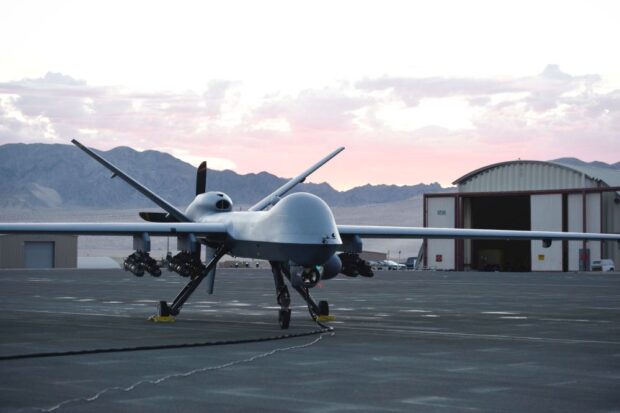A contractor caused $16 million in damages to a U.S. Air Force drone, according to a new accident investigation report. The MQ-9 was on loan from the service as part of a program to capture data from hypersonic tests before it crashed last year.
The crash took place Jan. 18, 2023, at Southern California Logistics Airport in Victorville, Calif. Crew members, while members of the California National Guard, were working as civilians for Integrated Innovation, Incorporated—known as i3—at the time.
i3 helps operate the Defense Department’s SkyRange program, which uses MQ-9 and RQ-4 drones to clear hypersonic test ranges and relay telemetry. The crash was not during a flight to support a hypersonic test; its purpose was to test operations and procedures for the MQ-9, according to the investigation report, released this week 14 months after the crash.
Air Force investigators determined that before takeoff, the crew chief and pilot failed to note during preflight checks that the drone’s angle of attack (AOA) gauge in the ground control station cockpit was displaying between 6.5 and 7.0 degrees, well outside the –1.0 it is supposed to show.
As a result, when the MQ-9 gathered speed to take off, warning messages and tones started flashing on the cockpit head’s up display. At that point, however, the drone had already reached 78 knots of indicated airspeed—the rotation speed at which point the pilot is supposed to initiate takeoff.
The drone sensor operator had not noticed or called out the aircraft reaching that speed and called for the flight to be aborted when the warning message appeared. When the MQ-9 left the ground, the drone pilot told the sensor operator to “Kill the GDT,” severing any sort of connection between the ground terminal and the aircraft.
The MQ-9, which never got more than 18 feet off the ground, slammed back into the runway and veered off to the left.
“As the [aircraft] careened into the dirt surface surrounding the runway, all three landing gears collapsed causing catastrophic damage to the aircraft’s radome, lower data link antenna, [Multi-Spectral Targeting System], and the engine,”
the accident investigation report states. The estimated cost of the damage was $16.1 million, though the report does not say if the aircraft was salvageable.
Ultimately, investigators determined the primary cause of the crash was the decision to sever the communications link between the aircraft and the ground terminal. Using a simulator, officials said they were able to determine that
“although the [aircraft] stalled and impacted the runway hard, not cutting the GDT allowed us to maintain aircraft control to a full-stop on the runway.”
Officials also faulted the pilot for failing to note the AOA gauge was displaying data that would cause an alarm, and the sensor operator for failing to call out when the MQ-9 reached rotation speed and attempting to abort the flight after rotation speed had been reached. All were “substantially contributing factors” to the crash.
Both the pilot and sensor operator were current and qualified to instruct and conduct MQ-9 launch and recovery operations, the report noted.
The drone was assigned to the 432nd Wing at Creech Air Force Base, Nev., but no personnel from that wing were involved in the mishap. The Air Force’s MQ-9 fleet averages about 4.9 Class A mishaps per year, according to the latest available data. Other MQ-9s have been damaged or destroyed by Russian aircraft and Houthi missiles in the past year.
i3 continues to work on SkyRange, which officials say has allowed the Pentagon to test hypersonic systems faster and more effectively than before—limited test capabilities and infrastructure have been common complaints in the U.S.’s hypersonic efforts.
Photo: A U.S. Air Force MQ-9 Reaper remotely piloted aircraft prepares to taxi at Marine Corps Air-Ground Combat Center, Twentynine Palms, California, Aug. 15, 2023. U.S. Air Force photo by Airman 1st Class Victoria Nuzzi
Source: Air & Space Forces

